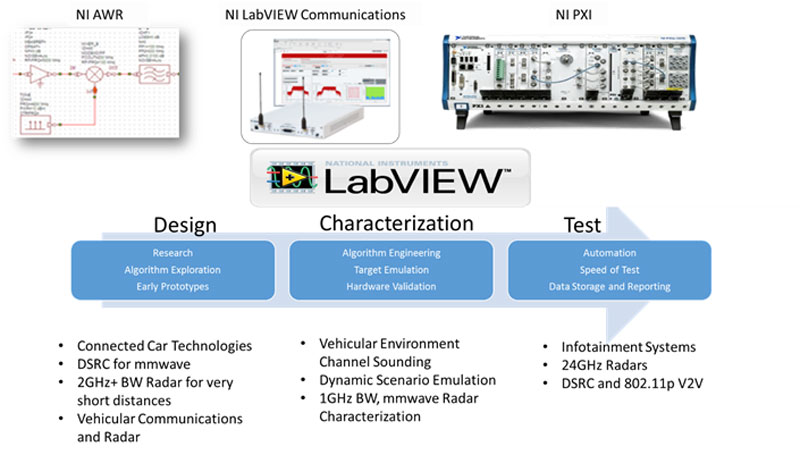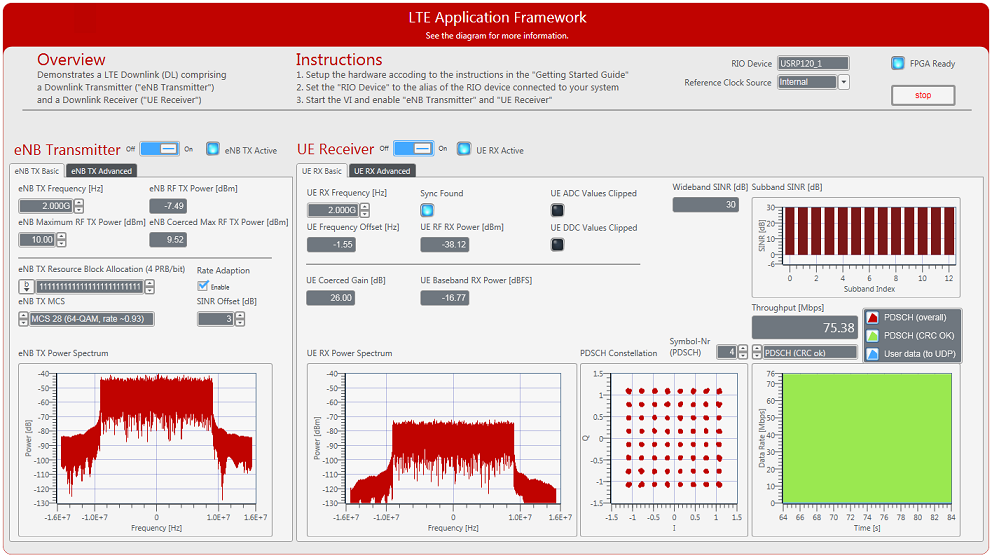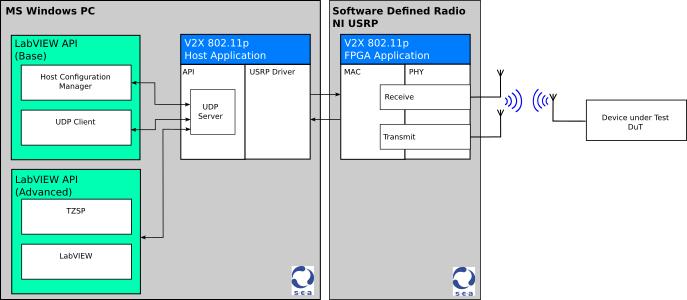Connectivity drives reliability in autonomous cars
Emerging wireless and cellular 5G technologies are bringing a new level of connectivity to cars and enabling many applications to support safety, efficiency, and Internet access. Connectivity is a natural complement to other kinds of automotive sensors that are also being integrated in vehicles.
Authors:
Dr. Robert Heath, Cullen Trust Endowed Professor, Wireless Networking and Communications Group, Department of Electrical and Computer Engineering, University of Texas at Austin
Abhay Samant, Section Manager, RF and Wireless Communications, National Instruments
Communication allows vehicles to exchange what they see and allows vehicles to expand their sensing range thus making better automated decisions. While radar and communication technology is quickly making its way to the validation and production test floors, engineers and scientists are actively working on innovative ideas to better understand how automated cars will better interact with non-automated objects on the road, drive synergy between vehicular radar and communications, and design wide bandwidth radars capable of resolving very short distances. To bring these technologies to market, the automotive industry needs to leverage a software-centric platform-based approach that helps accelerate the design, characterisation, and test phases.
Trends in connected car technologies
Wireless communication is bringing a new level of connectivity to cars. With wireless, cars may communicate with each other directly in Vehicle-To-Vehicle (V2V) mode, or through the infrastructure in Vehicle-To-Infrastructure (V2I) mode. There are many applications of connectivity to support safety, transportation efficiency, and of course Internet access. Connectivity is a natural complement to other kinds of automotive sensors that are being integrated in vehicles.
Vehicular connectivity has been investigated for at least twenty years. The defacto approach is dedicated short range communication (DSRC). This technology is envisioned primarily as a means for exchanging basic safety messages, though it also has some applications in traffic management. DSRC supports both V2V and V2I. After nearly 20 years of development, DSRC is now available in some US cars, though wide use will probably not have been seen without a government mandate.
Automated vehicles come in many flavors, depending on the level of automation. At one extreme is no automation, where the driver is in full control. At the other extreme, the vehicle is in complete control and there are no controls for any human assistance. At levels, in between, certain driving functions are automated but the human may still be in charge. For example, in a lower level of automation, the driver may be warned about a potential forward collision.
In a higher level of automation, the car may automatically apply the brakes and may also take evasive action to avoid the collision. While fully automated driving is often called 'autonomous driving', it is unlikely that full automation can happen simultaneously with full autonomy, which implies no communication. The reason is that fully automated high speed driving is difficult without communication of high resolution map data.
Connectivity is a critical component of vehicle automation because it enhances the sensing range of vehicles. Sensors being deployed for automation including automotive radar, visual cameras, and LIDAR. Radar is used for automatic cruise control, forward collision warning, lane change assistance, parking, and pre-crash applications. Visual cameras are used for safe backups, monitoring blind spots, nap prevention, and lane keeping. LIDAR provides high resolution 3D map information that can be used for autonomous navigation, as well as pedestrian and bicycle detection.
All three technologies are important for fully automated vehicles. For example, Tesla uses visual cameras for automated highway driving while Google cars make heavy use of LIDAR and 3D map data for accurate driving and navigation, and several radars to aid in the detection of other vehicles. The range of each technology depends on its configuration and the deployment scenario. For example, in rural areas, radar may achieve 200m, LIDAR 35 m, and visual cameras 30m, but in urban areas, the range of all these technologies diminishes to a few metres due to obstruction by other vehicles. Essentially, these external sensors are limited by what they can see. Communication allows vehicles to expand their sensing range by leveraging what can be seen by other vehicles in the front, back, or sides.
Mixed-use environments where vehicles have different levels of automation and communication remains a challenge. One approach is to deploy sensing at the base station, for example radar, visual cameras, or LIDAR. Then the information derived from sensors can be broadcast to connected vehicles, giving them situational awareness about non-connected vehicles, and non-vehicular users of roadways. The infrastructure based approach has the advantage that it works well even if most other vehicles do not have communication capability. Infrastructure will also make higher levels of automation more effective, for example to coordinate interactions of vehicles through intersections without the need for traffic lights. This infrastructure-based sensing will likely be built around 5G cellular communications, since they aim to provide much higher data rates.
At present, there is tremendous interest in the automotive use case for 5G. Applications include vehicular automation, transportation planning and operations, and of course infotainment. 5G will support 10x lower latencies and 10x higher bandwidths than 4G solutions making it especially suitable for automotive applications.
In particular, millimetre wave 5G is especially attractive because of very high data rates, which can be used for the exchange of raw sensor data. Millimetre wave for automotive applications is one of several ongoing research topics at The University of Texas at Austin. Other topics include the co-design of communication and radar, the use of low frequency communication signals as a low-cost means of automotive radar, and the use of sensing-based infrastructure to aid millimeter wave communication.
A platform based approach accelerates innovation and shortens time to market
Typical engineering projects go through phases of design, characterisation, and test. These phases are typically disjoint, with different tools and techniques used in each. To drive development efficiency in each phase and rapid transition to the next, NI provides a platform-based approach, which reduces barriers between each phase with a unifying environment based on common, well-integrated hardware and software components. At the heart of NI’s platform is LabVIEW software. This platform based approach accelerates productivity and reduces time spent in each phase.

Figure 1:
Design: Engineers and scientists around the world are exploring different connectivity and sensing technologies, at a variety of carrier frequencies, and with different bandwidths. Exploring synergies between vehicular radar and communications requires understanding design tradeoffs made at MAC and PHY layers. To enable rapid prototyping for radar and communications systems, a platform must provide extremely high data transfer and processing capabilities, especially to enable a prototype that operates in real time in real world conditions. To provide these capabilities, a platform must have fast parallel cores, high-speed bus for data transfers, and/or support FPGA processing capabilities, and of course support for advanced signal processing techniques.
Based on underlying hardware that provides these high-performance capabilities, the LabVIEW Communications System Design Suite (Figure 2) is a software environment that brings together discrete research, development and deployment steps within a single tool. This software suite tightly integrates with software defined radio hardware, including one with a programmable FPGA. The LTE and 802.11 Application Frameworks, included with the LabVIEW Communications System Design Suite, provide ready to run, easily modifiable real time physical layer (PHY) reference designs based on the LTE and 802.11 wireless standards.
These application frameworks provide a substantial starting point for researchers to find ways to improve the LTE and 802.11 standards. Some example research includes exploring new algorithms and architectures that can support the tremendous increase of the number of terminals, inventing new waveforms by which to modulate and demodulate the signals, or finding new multi-antenna architectures that fully exploit the degrees of freedom in the wireless medium.

Figure 2: To support design of ultra-wide bandwidth radar sensors, the NI AWR Design Environment platform, specifically Visual System Simulator (VSS), offers a complete software solution that enables engineers to design the right system architecture and formulate suitable specifications for such sensors.
Characterisation: Radar systems play a critical role in the reliability and safety aspects of autonomous vehicles. Additionally, auto makers and radar sensor manufacturers will need to continuously innovate on features to maintain their competitive edge in the market place and meet the evolving regulatory landscape.
Unfortunately, the traditional approach of creating a fixed-function instrument crafted to measure and test a specific category of scenarios is not scalable. To truly increase the scope of coverage, one cannot only rely on simulation, but rather directly with real world hardware and real world signals. NI LabVIEW and the NI PXIe-5646R Vector Signal Transceiver provide this flexibility through its software designed architecture.
Engineers can programme the FPGA on this device to emulate different types of static and mobile single and multi-point targets using the integrated RF and off-the-shelf millimetre wave radio heads.
NYU recently announced a 5G prototype and channel sounding system based on NI LabVIEW based software defined radio platform for the development and validation of mmWave systems. The automotive industry also needs to invest and build a mmWave channel sounding system to fully characterise and understand channel impacts on vehicular communications. This includes, but is not limited to, impact of blockage by vehicles, especially if the receive and transmit vehicles are in different lanes and to study whether rays reflected off other neighboring cars can provide good secondary path alternatives to the blocked line of sight path. If such reflectors can be used, traditional sensing technologies could be used to provide locations of potential reflectors and can be used for targeted beam formation.
Test: Because automated driving, and the components that enable it, is a safety-relevant function, these systems undergo mandatory and complex test and validation processes. To meet the challenges of such processes, an engineer must have the ability to evaluate a wide variety of scenarios throughout the design and implementation phases of the communication application and electronics. An open, modular platform is essential to provide flexibility and adaptability to meet the myriad conditions that may be encountered.
As commercially available 802.11p stacks do not easily allow failure injection on protocol level or do normally not provide access to internal logic S.E.A. Datentechnik GmbH has developed an extended 802.11p protocol stack (MAC and PHY) based on the NI platform. This protocol stack provides a full software interface (API) for LabVIEW.
Beside live communication the S.E.A. 802.11p provides extensions for testing and manipulation purposes, especially required for development, verification and validation test on signaling level. The protocol stack is implemented as FPGA code within the NI VST hardware to provide real time signal and data processing with precise timing and synchronisation abilities.

Figure 3: Implementation of the S.E.A. 802.11p protocol stack
The system provides processing of raw packets with exact time stamps containing all data that is send on the MAC layer. The transmission of data packets the air to the DUT can be controlled at precise points in time. This allows excellent synchronisation with other signals synthesised by the test system such as GPS, Radar or LIDAR sensor signals, or vehicular data. Received data packages from the DUT are time stamped and available in LabVIEW for further processing.
The Danlaw Mx-DSRC product tests interoperability and conformance of a DSRC module in an integrated vehicle environment (simulated or real), including vehicle bus and 802.11 physical layers, and DSRC communication testing to IEEE1609.4, 1609.3 and 1609.4, and performance level testing such as J2945/1.
Key to testing DSRC operation is confirming the quality of the RF link and the adherence to the various standards that define it. Andrew Donaldson, Program Manager, said that Danlaw selected National instruments to provide the RF test capability; the NI WLAN Test Suite and underlying PXI based test system provides all of the features required to fully test the RF capabilities of the DSRC device under test.
Summary
Emerging wireless and cellular 5G technologies are bringing a new level of connectivity to cars and enabling many applications to support safety, efficiency, and Internet access. Engineers and scientists are actively working on innovative ideas to better understand how automated cars will better interact with non-automated objects on the road, drive synergy between vehicular radar and communications, and design wide bandwidth radars capable of resolving very short distances.
The NI platform-based approach, with a software centric platform based on highly integrated software and hardware, accelerates design, characterisation and test phases, helping engineers to bring innovative ideas to market faster that will enhance driver experience and drive reliability into autonomous cars.


